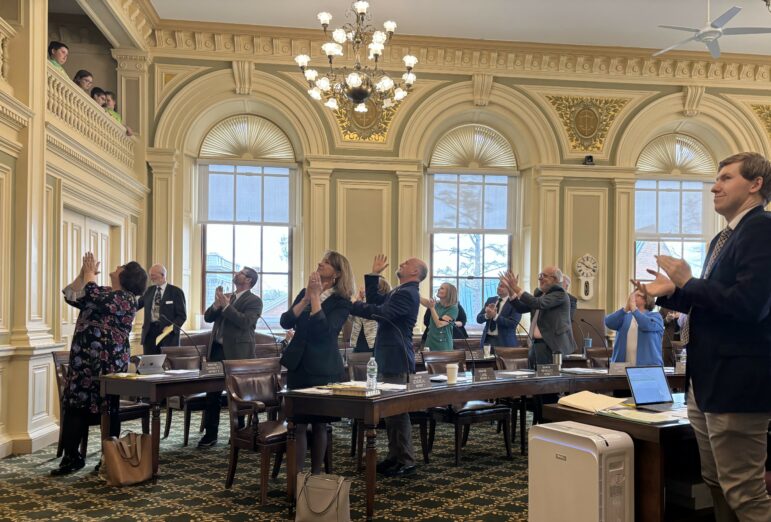
By GARRY RAYNO. InDepthNH.org
Most people think of the Department of Employment Security as the place you go to either look for a job or to collect unemployment when you do not have one.
The department also collects data and generates statistics through its Economic and Labor Market Information Bureau that is a treasure chest of information for anyone patient enough to read through its reports mapping where the state’s economy has been and where it needs to go.
Coming out of the COVID-19 pandemic the statistics and data helps to put a face on the rhetoric about the state’s economic recovery.
The public has constantly been told the state has the lowest unemployment rate in the country, when it has one of the lowest along with Vermont.
Vermont, like New Hampshire, had a quick recovery from the low points in the Spring of 2020 when New Hampshire’s unemployment rate hit 16 percent and Vermont’s was nearly 15 percent, while Connecticut and Maine’s peaked at about 9 percent.
But only New Hampshire and Vermont’s unemployment rates have returned to near pre pandemic levels, while the other New England states have lagged somewhat behind with Connecticut’s rate improving only 1 percent since that time.
The pandemic job losses were some of the worst in decades for most states including New Hampshire which lost 16.9 percent of its jobs when 131,000 people lost their livelihoods.
“This job loss was larger than seen in any recession over the past 50 years,” according to the department’s “Reviving New Hampshire’s Workforce: 2021 Economic Analysis Report.”
One of the reasons Vermont and New Hampshire rebounded as quickly as they did, was a secondary effect from the virus spreading rapidly in the nearby urban areas of New York City and Boston.
The large number of second homes in the two states not only helps to lower the property taxes for full-time residents, they also provided a rural refuge for their urban owners and their families from the virus’s spread.
Coupled with remote working, and there was a mass exodus to small towns spurring local economic activity and swelling school enrollment in some districts.
“The increase in demand for services due to a population surge resulted in a relatively quick return to a pre-pandemic labor market,” according to the report.
But the rebound has been uneven and while the unemployment rate may be about the same as it was before the pandemic, the number of people in the workforce is not.
Many people have not returned to the workforce, some retired, others left to care for children or other family members and others suffered burnout or want to avoid the risk of infection.
According to the report, the proportion of the population in the workforce now is lower than it was during the Great Recession.
The employment to population ratio offers insight into how much slack there is in the labor market, according to the report.
“In contrast to the relatively strong recovery the unemployment rate indicates, the employment to population ratio provides a broader perspective on the condition of the labor market,” the report notes.
Many of the reasons workers left the job market, like child care or helping children with remote learning or fear of infection, have been mitigated and the waiver of having to seek work to collect unemployment benefits has ended.
But the ratio has not returned to its pre-pandemic level.
The report notes at the height of the job loss, in April 2020, the ratio bottomed out at 54.7 percent, a low not seen since 1976.
While the ratio has rebounded since that time to about 67 percent it has not yet reached pre pandemic levels.
The report’s main author, economist Annette Nielsen, notes the same is true for the other New England states as well.
The job loss in New Hampshire in April 2020, showed an employed workforce of 617,340, down 2.5 percent from before the pandemic.
The state began adding jobs back but has not fully recovered all the lost jobs.
‘The current status of the labor market, approximately two percentage points below the pre-recession peak, is still below the trough of earlier recessions in New Hampshire, with the exception of recessions in 1990 and 2007-2009,” according to the report.
Using past recoveries as indication, fully replacing all the lost jobs will take some time.
And some industries continue to struggle to return to prior levels and some are hampered by the difficulty in finding workers.
Most everyone knows the hardest hit sector of the economy has been the leisure and hospitality industries, the restaurants, hotels, and concert and art venues.
The job losses in those industries totaled nearly 40,000 as they were deemed nonessential services and had to close during the early days of the pandemic.
While many of those jobs have returned, the sector has about one-quarter fewer employees than before the pandemic.
Other industries with significant job losses were education and health care, and trade, transportation and utilities as both sectors experienced job losses of more than 20,000.
While the trade, transportation and utilities sector has rebounded significantly, the education and health care sector has not as about half the jobs have not returned.
The one sector of the economy that has more than rebounded is the professional and business services sector which has added about 3,700 jobs more than it had prior to COVID-19.
The report also details what has been reported before that pandemic job loss has impacted women more than men.
The Great Recession impacted men more than women and more women were employed in private industry than men from 2007 until 2015, but since that time more men are working than women.
“By age cohort, the participation rate by gender differed, though the participation rates for both females and males under age 25 increased. The largest drop in the labor force participation rate among females was in the age cohort 25 to 34 years and among females over the age of 65,” according to the report, which corresponds to reports of women leaving to be caregivers to their children and older women exiting the workforce due to health concerns.
And the report shows the pandemic exacerbated a long known problem that New Hampshire has an aging workforce in critical areas and is not attracting younger workers quickly enough to replace them.
In 2019, 27.5 percent of New Hampshire’s workers were age 55 and above, up from 19.4 percent in 2009, according to the report, and the share of older workers increased in every industry sector with the greatest increases in manufacturing, utilities and information services.
“The high concentration of older workers in manufacturing continues to be a troubling trend, because of the potential loss of knowledge and skill as these workers retire and the importance of the manufacturing industry to New Hampshire’s economy,” the author writes.
How long older workers remain in the workforce could depend on the easing of the pandemic and if companies want workers to come back to the office, the report notes.
“Will there be a sudden post-pandemic tsunami of retirements?” the author asks.
And what can be done to entice younger workers into the sectors older workers are leaving?
New Hampshire has long had a problem retaining its young people, particularly those who are well educated.
While the state’s leaders have been touting the quick recovery, they have done little to address replacing the aging workforce and that is a long-term problem needing attention.
The pandemic has been a learning experience. It has taught us the need to upgrade broadband infrastructure, that telemedicine is the wave of the future and you can work remotely from anywhere.
Whether it teaches us we need to pay more attention to the workforce and how to retain the best and the brightest, remains an open question.
Garry Rayno may be reached at garry.rayno@yahoo.com.
Distant Dome by veteran journalist Garry Rayno explores a broader perspective on the State House and state happenings for InDepthNH.org. Over his three-decade career, Rayno covered the NH State House for the New Hampshire Union Leader and Foster’s Daily Democrat. During his career, his coverage spanned the news spectrum, from local planning, school and select boards, to national issues such as electric industry deregulation and Presidential primaries. Rayno lives with his wife Carolyn in New London.





